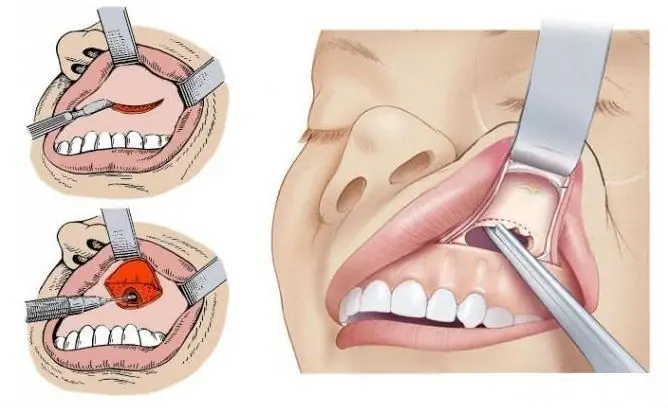- Author Rachel Wainwright [email protected].
- Public 2023-12-15 07:39.
- Last modified 2025-11-02 20:14.
Paraurethral cyst

A paraurethral cyst is a closed cystic formation filled with secretion, localized in the region of the mouth of the urethra, less often in the canal itself.
Skene's glands (small vestibular glands, paraurethral glands) are glands located in the area of the external opening of the urethra on the anterior wall of the vagina, throughout the spongy body of the urethra. These glands produce a secret that moisturizes the urethral mucosa. In some cases, the mouths of the Skene's glands narrow, close, clog up, and the inner cavity of the gland is filled with the secretion produced, stretching its walls and forming a paraurethral cyst.
A paraurethral cyst in most cases is diagnosed in women of childbearing age, which is associated with the susceptibility of the glands to significant changes in different periods of a woman's life. During pregnancy, women experience glandular hypertrophy, in the postpartum period, involution is observed, the climacteric period is characterized by atrophy of the paraurethral glands.
A paraurethral cyst is a small tumor-like formation of a round shape, located mainly at the external opening of the urethra, less often in depth from the surface tissues, which significantly complicates the diagnosis of a neoplasm. The paraurethral cyst is palpable from the side of the vagina; when pressed, a mucous fluid can be released. With a complication of cystic formation by an infectious and inflammatory process, discharge can be purulent. An uncomplicated paraurethral cyst is characterized by an elastic consistency, the absence of inflamed tissues in the area of cystic formation.
There are two types of paraurethral cysts:
- Skinian paraurethral cysts - cystic formations that occur when small glands located around the urethra are blocked;
- Gartner's passage cysts are cysts arising from an anomaly in the development of the female genitourinary system. In rare cases, the germinal ducts between the vaginal wall and the urethra do not overgrow, which leads to the accumulation of fluid in them and the formation of a cyst.
A paraurethral cyst of any type does not regress or resolve on its own. The longer a cyst exists in the urethra or on the eve of it, the more likely it is to develop inflammation and suppuration. Paraurethral cysts are a favorable environment for the accumulation of stagnant urine and the growth of bacteria. Inflammation of the paraurethral cyst can lead to the development of an abscess, which opens into the urethra with the subsequent development of a diverticulum.
Diagnosis and symptoms of paraurethral cysts
An uncomplicated paraurethral cyst, as a rule, is asymptomatic, does not cause discomfort to the patient, and remains unnoticed for a long time. With an asymptomatic course of the disease, paraurethral cysts are detected only during a preventive gynecological or urological examination. A paraurethral cyst in women can either protrude along the anterior wall of the vagina, or be localized in the thickness of the labia minora.
Deeply located paraurethral cysts are diagnosed based on the clinical picture. Diagnostics is carried out by the method of endoscopic examination of the urethra (urethrocystoscopy), which allows you to determine the localization and size of the formation.
Also, for the diagnosis of paraurethral cysts, an ultrasound method is used, carried out by an intracavitary transducer.

To differentiate a paraurethral cyst from other diseases (vaginal cysts, tumors of the anterior vaginal wall, diverticulum), a number of tests are performed (general urine analysis, bacteriological urine culture, urine cytological examination).
When the cyst reaches a significant size, the patient may be disturbed by the following symptoms:
- Discomfort while walking, sexual contact;
- The formation of swelling, edema in the urethra;
- Violation of urination, dysuria;
- Pain, burning sensation in education;
- Slight purulent discharge;
- General symptoms characteristic of the inflammatory process;
- Frequent urination;
- Bursting feeling in the area of cyst formation;
- Urination accompanied by cuts;
- Urinary incontinence.
A paraurethral cyst can be complicated by an infectious and inflammatory process, in which cyst suppuration is observed, which leads to the appearance of purulent discharge.
Reasons for the formation of paraurethral cysts
The formation of paraurethral cysts is associated both with various inflammatory processes of the genitourinary system (urethritis, also caused by sexually transmitted infections), and with microtrauma of the urethra (with rough sexual contact, labor). In rare cases, a paraurethral cyst may be congenital.
Also, the reasons for the development of paraurethral cysts include the use of various means of intimate hygiene based on soaps, which leads to obstruction of the excretory ducts of the paraurethral glands. Decreased immunity is another reason for the formation of paraurethral cysts.
Methods for the treatment of paraurethral cysts: surgery, drug treatment
When diagnosing a paraurethral cyst, an important step is to determine the reasons that caused the formation of a neoplasm. If the causes of cystic formation are identified, the patient is prescribed complex therapy, combining conservative methods (drug treatment aimed at eliminating the inflammatory process, infection) and radical (involving the removal of the paraurethral cyst). Opening a paraurethral cyst gives only a temporary effect, since when the mouth of the gland is blocked, the cyst forms again.
It is believed that in the diagnosis of a paraurethral cyst, the operation is the only correct and effective way to treat neoplasms. With a paraurethral cyst, the operation can be performed using various techniques, with preference given to complete excision of the cystic formation. Depending on the type of paraurethral cyst, the operation can be performed both under local anesthesia and under general anesthesia.
Removal of a paraurethral cyst: prognosis, risks
Removal of a paraurethral cyst entails certain risks and complications, the likelihood of which depends both on the complexity of the paraurethral cyst itself (complication of an infectious and inflammatory process, size, localization of the formation), and on the experience of the surgeon. Among the main complications and risks associated with the removal of a paraurethral cyst are:
- Stricture (narrowing, often accompanied by inflammation) of the urethra;
- Relapse of education;
- Development of urethral pain syndrome;
- Urethro-vaginal and vesicovaginal fistulas;
- Hematoma formation;
- Bleeding of varying intensity;
- Recurrent infection.
YouTube video related to the article:
The information is generalized and provided for informational purposes only. At the first sign of illness, see your doctor. Self-medication is hazardous to health!






